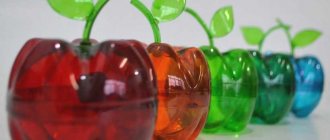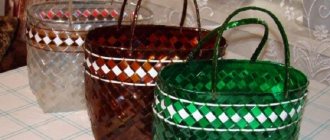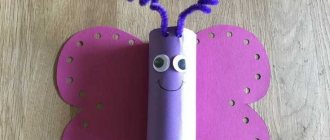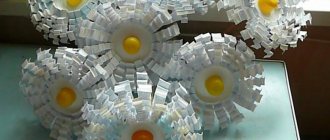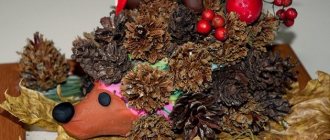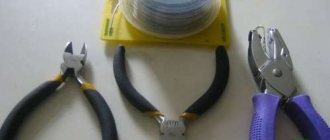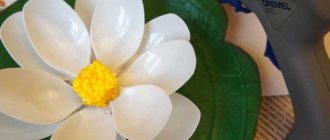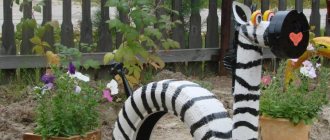Loading…
Loading…
The trend of rational use of household waste has recently become increasingly popular, especially with regard to plastic containers. From plastic bottles you can make almost the entire country house interior and more with your own hands. One of the main advantages of this material is its long service life, and it is also very elastic. Don’t forget that plastic bottles are an affordable material that every owner or housewife always has in stock.
By showing ingenuity and a little imagination, you can not only make necessary and useful things that will decorate the site, but also free it from unnecessary trash without harming nature. After all, it is known that plastic takes a very long time to decompose, and when burned, it releases hazardous substances. Therefore, it is better not to throw bottles into a fire or take them to a landfill - they can still serve in the form of a variety of homemade products, some versions of which are presented in the article. Read: flower beds made from tires, original ideas!
Cheap and cheerful - we make flower beds from bottles
Plastic containers are an ideal option for flower beds, as they have a great advantage over wood and even metal. Wooden fencing in flower beds or flower beds dries out over time or rots under the influence of moisture and sun. Even metal curbs are susceptible to corrosion and require periodic maintenance, such as regular painting.
What about plastic? It does not lose its shape and does not collapse for a long time. This means that such a flower bed will last for more than one season or even one year, and it also requires absolutely no maintenance. Even if a “breakdown” occurs, the required “element” can always be found in the pantry and easily replaced, without resorting to long, tedious shopping trips to find a suitable fragment.
So, what can you make from plastic bottles with your own hands?
See the topic for ideas for the garden!
Bottle borders
If you need to fence a flower garden, plastic containers of different sizes will do the job perfectly. Such a border will not only limit the space and prevent the growth of perennial plants, but will also retain moisture and prevent the appearance of weeds.
The shape and size of the flowerbed depend only on the imagination of the summer resident: it can be either equilateral or in the form of some kind of animal or plant. You can also use bottles to break the flowerbed itself into segments.
Even a child can build a bottle border (with the help of adults, of course):
- The first step is to draw the contours of the flower bed with a sharp object or sprinkle sand on the site.
- Remove the labels from the bottles, wash them, pour sand into them and screw on the cap. If this is not available, you can use ordinary soil or water. This is necessary for stability, since empty containers will quickly fall out of the fence.
- Dig a groove along the outlined contour so that the bottle can be deepened into it by about 1/3.
- Place the filled bottles in the groove with the neck down, as close to each other as possible, and cover with soil.
For visual effect, you can use bottles made of different colored plastic (green, white, brown).
Some summer residents do without digging in bottles. For example, bottles without a bottom are simply inserted into each other, forming a circle. The finished structure can be “put” on a bush or taken into a ring around the trunk of a tree. To secure the curb, it must be pressed tightly to the ground with arcs.
Multi-tiered flower bed
If you really want to have a flower garden, but there is too little space, you can make a multi-tiered flower bed with your own hands from plastic bottles. The principle is the same as when constructing a border, only after laying the first tier it is necessary to fill it with nutritious soil, and only then lay out the next floor.
When planting plants for the lower tier, it is better to choose moisture-loving specimens, since when watering the water will flow down.
Mini flower beds
Beautiful and useful crafts for the garden can be made from 5-liter plastic bottles. They will serve as miniature and cute flower beds, for example, in the shape of everyone’s favorite piglets.
Group compositions in the form of trains with flowers look no less impressive.
And if you sow lawn grass instead of flowers, the large bottle turns into a cute hedgehog with green spines. All that remains is to attach the eyes and nose.
Those who are not afraid of small rodents will like cute mice from small (liter) bottles. They are good for planting petunias.
Flower pots and flowerpots
With a little imagination, plastic bottles can easily be transformed into small decorative pots for flowers or herbs. You can make them even or cut them to fit a marker in the shape of a face. Such flowerpots will look great not only in a garden gazebo, but also on a windowsill in a house.
But if you put a fabric cover on the cut bottle and attach ropes, you will get elegant flowerpots for the summer veranda.
The easiest way to make hanging pots is to cut out fragments of the walls on both sides of the bottle, and secure a rope under the neck for hanging. Compact, low-growing plants can be planted in such flowerpots.
Ideas for garden crafts made from plastic bottles
PET material is lightweight and, moreover, durable, so you can easily and quickly make any thing from it. I'll start by showing the huge vehicles. Oh, and now there will be impressions.
All sorts of bottles, even canisters, will be suitable for this purpose. Look how much work there is here. If you have children, they will be interested in such products. Choose any job and create a whole composition in your garden plot.
You can also take equipment, airplanes or helicopters as a basis.
You can also make a masterpiece from a shampoo jar and you will get an airplane. Paint with acrylic paints so that weather conditions do not spoil the craft.
The furniture still looks wonderful, it would seem, that’s it. Of course, you need quite a lot of the required material here.
And the author of this work thought of making a boat. It looks awesome, don't you think?
Entire houses are already being cultivated and greenhouses are being built. Gazebos made from such waste materials also began to be in demand.
And of course furniture items such as chairs, stools and trash cans. Well, everyone will definitely like this.
You can also make an ottoman and place it, for example, in a bathhouse or gazebo. So don't throw away your juice cans.
Let's move on and see that you can design and decorate the trees in the garden.
And place mushrooms under them, and these could be fly agaric mushrooms. Imagine and success will come on its own.
Decorative decorations are also made for the fence, the bottoms of bottles are cut off and scenes are laid out.
Stumps and benches are also decorated. It comes out bright and beautiful.
Flowers and sunshine are cultivated in playgrounds and schools. These are the most famous works.
And of course you can’t do without flower beds and flower beds. You can even make it from one ordinary transparent soda bottle. What a wonderful mouse came out.
Or make regular pots and plant any climbing plant or flower there.
It looks quite wonderful and cute, they even built a magic ball.
Whoever is good at something creates. It surprises us, but we follow the example and don’t lag behind.
This picture is also very beautiful, but imagine if you also plant daisies or other flowers and how it will all bloom.
Unusual butterflies will also be an excellent decoration. They will cheer you up and make the interior even more beautiful.
You will need a template, cut it out of paper, and then attach it to the bottle.
Trace and paint with acrylic paints, and then cut out along the outline.
Or these funny turtles.
Make them with your children and decorate the veranda or dressing room. Here's a step-by-step photo instruction in detail; by the way, it's also a piggy bank.
Making a beautiful garden path
Paths made from plastic containers are especially popular among summer residents. The strength of such a path depends on the laying method and what part of the plastic container serves as building material:
- Laying cut bottoms in sand. Dig a trench along the width of the passage, fill it first with construction waste and then with sand. Moisturize it. Cut off the bottoms of the bottles (leaving ½ part) and lay them out tightly, compacting them into the sand. To prevent the bottoms from moving apart, you can fill the space with fine gravel.
- Laying plugs in cement mortar. Fill the prepared trench with a solution (1 part cement, 4 parts sand and a little construction glue) and deepen the lids into it, laying them out in colors or patterns.
Paths made of plastic bottles become very slippery in winter.
Crafts from corks
Corks are widely used for DIY projects. In the garden, they are used to make flowers, toys and decorate flat surfaces: garden paths, platbands, furniture, walls of gazebos, houses and barns. Master classes and numerous ideas for DIY crafts made from corks are widespread on the Internet.
Road of traffic jams
Corks are an excellent material for decorating garden paths. They are not subject to rotting, do not fade, and adhere well to cement mortar. The color range of commercially produced corks allows you to create multi-colored patterns, realizing the most interesting ideas and fantasies.
To make a path decorated with corks, you will need sand, cement, reinforcement, formwork boards, and multi-colored corks.
Stages of work:
- using thin twine, mark the location of the future path;
- a pit is being dug in place of the future path. The width of the pit is equal to the width of the path plus 5 cm, the depth is 10 cm. Formwork boards are installed along the edges of the pit. The boards are fixed vertically with pegs;
- Using a concrete mixer, ½ of the pit along the height is filled with cement mortar. To prepare the solution, cement and sand are mixed in a concrete mixer in a ratio of 1 to 4;
- reinforcement bars are placed in the solution to prevent the path from cracking. Metal rods, corners, old water pipes of small diameter can be used as fittings;
- the pit is filled with mortar and carefully leveled;
- the cork is pressed into the concrete solution, forming patterns on the surface of the path;
- one day after the concrete has hardened, the paths are swept with a stiff brush, removing concrete adhering to the plugs.
Mosaic of traffic jams
Mosaics made from corks decorate the platbands and walls of houses. To make it, wooden surfaces are pre-treated several times with drying oil, brick surfaces are freed of paint and plaster. Before starting work, a sketch of the project is made on paper, the required number of plugs is calculated and collected. Glue the cork to the base with superglue or using a glue gun.
Chamomile Flower
Delicate daisies can be used to beautifully decorate a relaxation area. To make a flower you need 7 plugs (yellow and 6 white) and a thick branch 30-40 cm long.
Stages of work:
- using a glue gun, the side surfaces of the corks are glued together in the shape of a daisy;
- after the glue has completely hardened, the flower is turned over, glue is poured 1/3 into the central plug and a branch is inserted into the glue melt with its end;
- After the glue hardens, the flower is “planted” in the flowerbed.
By combining different colors of corks you can get a colorful flower bed.
Plastic bottles are not only garbage, but also an almost inexhaustible source of material for useful homemade products for the garden. Making crafts from plastic bottles for the garden does not require a large set of tools and is feasible for any craftsman. Photos and descriptions of the works can be found on the Internet.
Fun playground - decorating a place for children to play
Caring parents always strive to provide their children with a place to play in their dacha, where the children can while away the time while the adults are busy in the garden. Of course, it should not only be safe, but also colorful so that the kids will like it. With the help of plastic bottles it is easy to decorate the playground by making a variety of plants and animals. Regular paint will help give them brightness.
In the shade under a palm tree
What is a children's playground without a sandbox? And where there is sand, a palm tree must “grow”. For the tropicana, you will need green and brown bottles for the trunk and leaves, respectively.
Before you begin assembly, you need to make sure you have a solid base. For example, fix a metal pin in a concrete screed, and it should be quite long so that the tree becomes tall and children can walk freely under it.
When the base is fixed, you can start “growing” the palm tree:
- cut off half the bottle (the top and neck are not needed) and form a jagged edge;
- Make a hole in the center of the bottom, string the blanks onto the base pin, bending the teeth to the side for a more natural look;
- cut off the bottom of the green bottle and make straight cuts along the entire contour to the place where the wall meets the neck (if desired, the branches can be made into shapes - cut into 4 parts and make teeth on each one);
- string fragments of the branch onto the base;
- firmly attach the finished branches to the top of the stem (by welding or construction cords).
If after assembling the palm tree there are still a lot of green bottles left, you can use them to make a small (or large) Christmas tree. Remove the bottom of the bottle and cut it into long narrow strips right up to the neck. Trim the edges of the strips to resemble thorns. String the leaves onto the base.
Such a Christmas tree will look great on the site in winter, especially under the snow, and will also help out on New Year's Eve those who, in a hurry, did not have time to buy a living tree.
Guests from a fairy tale - funny animals
And of course, there must be toys on the dacha playground. Children often take their old favorites outside. With the help of plastic bottles, you can easily diversify the “zoo”, creating real masterpieces - from the fairy-tale Frog Princess and Goldfish to modern cartoon characters.
Take, for example, a handsome cat, painted with black and white paint. Or you can use brown beer bottles and you will get a brown cat, also beautiful.
Form a head from two bottle bottoms (connect them), and the curves on the bottoms will indeed look like a real head. On one of them, paint eyes, eyebrows and mustaches with white paint, and a neat tongue with red paint. Insert small cut out ears on top. For the body, string the same short-cut bottoms onto the base, closing the body last. Melt the edges of the bottoms. Apply white paint along the melted contour of the ears and body fragments, and make a white spot on the chest on the front bottom.
Glue the head and legs - the top parts of bottles with elongated necks will be useful for them. Cut them to the place where the bottle expands, cut the edges with sharp teeth and build legs from 4-5 parts, putting them on the base wire. Screw the plugs onto the upper necks and use them to glue the legs to the body. For the tail, take a long wire and string the narrowest parts of the neck onto it, but without the plugs. To make the tail fluffy, cut the edges into thin strips.
Beautiful animals from plastic bottles are also obtained from large 5-liter containers. With the right combination of bottles of different sizes and with the help of bright colors, you can place a zebra, horse, cow, donkey and even a giraffe on the site.
Flowers for my daughter
In the sandbox, children not only make Easter cakes. Little girls love flowers very much and often pick dandelions on the lawn (or roses from their mother’s flowerbed) to plant in their sand garden. But you can make a whole greenhouse of flowers from bottles, and little girls will be happy to take part in making the simplest options. Chamomiles, cornflowers and tulips will decorate the sandbox, especially since young flower growers will be able to repeatedly “transplant” them from bed to bed without harm to the plants or mother’s nerves.
For flowers you will need:
- wire for the stem;
- straight parts of bottles for cutting leaves out of them;
- necks or bottoms for the inflorescences themselves;
- dye.
Adults can make more complex versions. Plastic roses or poppies will decorate not only the playground, but also the flower bed.
Create an elephant
To make a wonderful baby elephant, you will need the following materials and tools:
- Six liter bottles - two pieces;
- Two liter bottles - six pieces;
- Corrugated tube of small diameter, half a meter long;
- Thick wire 55 centimeters long;
- Sand;
- Glue;
- Scissors.
Related article: Quick ways to clean the soleplate of your iron
First, take four two-liter bottles and cut them in half crosswise. The underside will become the legs of the future baby elephant. Now we take a six-liter bottle and make ears out of it, after which we take a second six-liter bottle and make holes in it to fix the ears. After this, we take the wire and bend it, giving it the shape of an elephant’s trunk, and put a corrugated tube on top of it.
The time has come to paint all the blanks; you can use natural gray, or any other color you wish. When the paint dries, you can assemble the baby elephant.
We take the parts of the legs and fill them with sand, after which we glue them to the body of the animal. The trunk must be fixed to the neck of a six-liter bottle used as a body. Now we insert and fix the elephant ears in specially made holes. All that remains is to take paints and draw the elephant’s eyes and mouth.
Now the cute and funny baby elephant is finished.
Plastic design for garden
Garden crafts made from plastic bottles have a wide range of applications. So, if small animals and birds look appropriate in flower beds and playgrounds, then larger animals can be placed in the garden, among trees and shrubs. They will give the garden a unique look and enliven it.
Amazing garden sculptures
Representatives of large birds made of plastic look almost alive. Using multi-colored paints you can achieve a stunning realistic effect. To make them, you just need to master the technique of cutting feathers from the sides of bottles and prepare a frame on which they will be attached.
The following will look very impressive in the garden:
- peacock;
- flamingo;
- eagle.
In the garden you can place sculptures of not only birds, but also animals of a large enough size so that they do not get lost against the background of tall trees.
Among the greenery, a bright spot will be a white sheep, which is quite easy to make if you have 2 liter bottles and several 1.5 liter bottles lying around in the pantry:
- Cut the necks of two 2 liter bottles and put them on top of each other - this will be an elongated head. Cut out long ears from the third bottle, roll them up a little into a tube and attach them to the head in appropriate places with wire (or glue). You can draw eyes or glue two corks.
- For the body, insert the whole bottle with the neck inside into the cut-off top. Make 3 more such blanks and attach them to the first one on the sides and top, thus giving the sheep the desired “waist” volume.
- The neck will be a whole two-liter bottle, which should be attached to the body at an angle of approximately 120 degrees so that the cork is on top.
- Place the head to the neck (on the plug).
- For the legs, cut off the top of a two-liter bottle and insert a whole bottle of a smaller volume (1.5 l) into it. Make three more such blanks and attach the legs to the body with the wide part up.
- Make a fleece from the cut bottoms of two-liter bottles, fastening them together, and put them on the body. Grip the edges of the fur coat under your belly.
- Paint the sheep with white paint and draw black eyes.
Caring for birds
Plastic bottles can be used not only for decorative purposes, but also for the benefit of the garden. After all, it is always inhabited by the summer resident’s little helpers - various birds that collect pests from the trees. In the warm summer they have something to eat, but in winter it becomes more difficult to get food. That’s when the feeders hanging around the garden will come in handy. And if you involve children in the process, you get a double benefit: the children get an interesting activity and pleasure, and the birds get a cozy house with grains.
The simplest feeders can be made from large 5 liter plastic bottles by simply cutting large arch-shaped holes on both sides.
To prevent birds from injuring their paws on the sharp edges of the bottle, they must first be melted or covered with electrical tape.
For those who rarely visit their summer cottage in winter, a feeder that fills automatically will come in handy.
You can make it from a bottle and two wooden spoons:
- make two holes in the bottle opposite each other, with the second one located slightly lower;
- unfold the bottle and repeat the procedure on the reverse side;
- insert the spoons crosswise into the holes.
After the bottle is filled with food, it will be poured through the holes into the spoons as they are emptied.
Cute pig
In order to make a cute pig, you will need to prepare:
- Five liter plastic bottles;
- Acrylic paint;
- Varnish;
- Scissors;
- Dish sponge;
- Marker.
Article on the topic: Crochet elastic band in a circle: diagram with description and video
First, we take the bottle and remove all unnecessary parts from it, such as rims and handles.
Now we mark with a marker and cut out an oblong hole almost from the bottom to the throat, and above it on the back side, we make another wider hole. From scraps we make ears and a tail for a piglet.
Now you need to paint our animal in any color you like. We paint in two or three layers, and when the paint dries, it is necessary to varnish the product. Such a pig can be very useful in the garden and can be used as a flowerbed for growing flowers.
A cozy place to relax using improvised means
Not only birds, but also the owners themselves should have their own secluded corner among the greenery, where on warm summer evenings you can happily drink a cup of tea, inhaling the aromas of nature. Many people prefer to install wooden gazebos in the garden. They are very beautiful, you can’t argue with that, but they require certain financial investments. But it’s cheap and cheerful to make from plastic not only a recreation area, but also to completely equip it.
Alcove? Easily!
A gazebo is one of the largest-scale garden crafts made from plastic bottles. But a plastic gazebo has two big advantages:
- it is easy to assemble;
- will last for more than one year without damaging the material.
Perhaps the only drawback of the building is the presence of a large number of bottles, which need to be stored somewhere during the collection process.
What the gazebo will look like depends only on the desire of the owner, and, accordingly, on the availability of “building materials”:
- If there are not too many bottles, they can be placed on the walls, and the roof can be made of profiles or metal tiles.
- But if you make not only the walls, but also the roof from bottles, you will get a real summer house, which, by the way, will be warm almost until the end of autumn, because plastic holds the temperature very well.
- The simplest option for a recreation area is a regular canopy that will protect you from the sun and rain. Those who consider plastic crafts to be rude and ugly simply need to make a canopy from transparent containers and paint the bottoms (only in the shape of a flower) with multi-colored paints. A feeling of weightlessness is immediately created; it seems as if clouds of flower butterflies are hovering overhead. One awkward wave of the hand and they will immediately fly away.
Practical curtains for the gazebo
In summer gazebos there is a lot of fresh air, but, unfortunately, also dust. Ordinary tulle requires frequent washing, while a plastic curtain does not collect as much dust, and you can “wash” it without even removing it - just spray it with water from a hose (of course, if such a curtain is not hanging in the house).
For dreamy and romantic housewives, delicate curtains made from the bottoms of plastic bottles strung on a base are suitable.
Energetic people who love bright colors are more suitable for cork curtains assembled according to the same principle.
garden furniture
A table, ottoman, armchair and even a sofa in a gazebo can also be made from plastic bottles. Old furniture from home is also quite suitable for outdoor recreation, but, like curtains, it will eventually become a collection of dust. In addition, it is quite difficult to take a wooden sofa outside, because such furniture is quite bulky and heavy. But rearranging the plastic chair will not be difficult.
Assembling the furniture is not difficult - the bottles just need to be placed tightly and connected together with tape, giving the desired shape. For ottomans, knitting or sewing a cape - no one from the outside will guess what they are actually made of.
Leatherette covers are more suitable for a sofa.
Unbreakable chandeliers for the garden
If you are planning an evening tea party, the gazebo must be illuminated. To decorate the light bulb, you can cut the bottle into two parts and make a simple lampshade from the upper half and paint it or cover it with colored thread.
In plastic chandeliers, it is better to use energy-efficient light bulbs - they do not heat up so much and will not melt the material.
In more complex versions, chandeliers are assembled from fragments of leaves or flowers cut from multi-colored bottles.
Gardening supplies for gardening
In order for a summer cottage to look beautiful and tidy, it is necessary to take care of it all the time - weeding, collecting fallen leaves and small debris. To do this you will need tools. Of course, you won’t be able to make a hoe or rake out of plastic, but simpler ones are quite possible.
Craftsmen have long known how to use plastic bottles to benefit themselves and save the family budget. After all, if the scoop suddenly breaks, you no longer have to run to the store for a new one. From household waste, which is found in every home, a lot of useful things are obtained at no extra cost:
- Scoops.
- Broom.
- Bucket.
- Wash basin.
Garden cares
From plastic bottles you can make useful things not only for the garden, but also for the vegetable garden. These can be either small crafts in the form of repellers or larger-scale structures such as greenhouses.
Greenhouses for seedlings
Most summer residents grow seedlings of garden crops on their own. Some do this in apartment conditions, but better quality seedlings are obtained from greenhouses - there is enough heat and light.
There is no need to talk about cost, but as for durability - greenhouses made from plastic bottles will certainly last longer than film shelters or glass structures.
To increase the service life of greenhouses made from plastic bottles, it is advisable to place them on a foundation and use a metal profile for the frame.
The simplest version of a greenhouse involves constructing walls from whole bottles that are placed on top of each other.
It will take a little longer to tinker with a greenhouse made of plates, but it will turn out warmer. In this case, you need to cut out even parts from the bottles and fasten (sew) them together in the form of a canvas. Use ready-made canvases to assemble a greenhouse.
Watering "systems"
For gardeners, watering is no less pressing issue than having a greenhouse. Instead of ready-made watering systems, you can use plastic bottles in the garden. They must either be hung above the bush, having previously made holes in the lower part, or dug into the ground.
In addition, the bottle makes a good sprinkler - you just need to make small holes in it and connect it to a watering hose.
Getting rid of pests
A repeller made from a plastic bottle will help drive away the gardener’s worst enemy, the mole, from the property. It not only plows up the beds, digging its tunnels, but also damages the root system of plants in the process, depriving gardeners of the future harvest.
If you cut the side walls of the bottle, bend them and put the container on a steel rod, when there is a gust of wind, the bottle will spin and make noise. The sound will go into the ground through the rod and deprive the mole of the desire to manage in this noisy place.
The list of things you can make from a plastic bottle with your own hands is quite long. These are just a few crafts that make life easier for summer residents. Agree – it’s better to get the most out of bottles than to pollute the environment. Take care of nature and work with pleasure!
